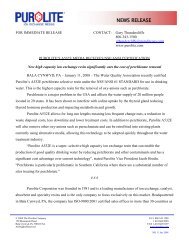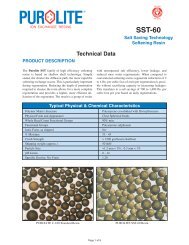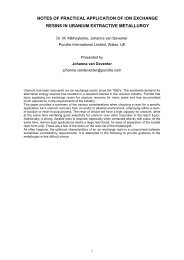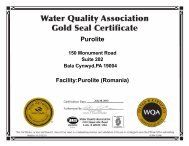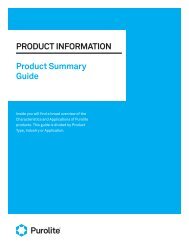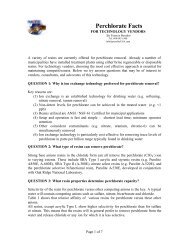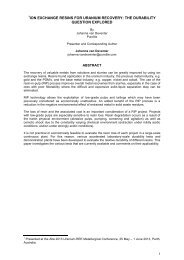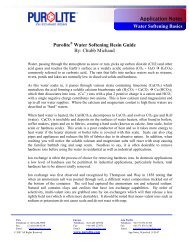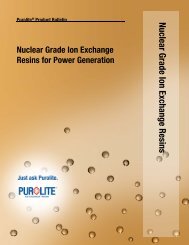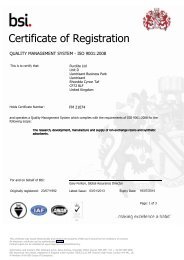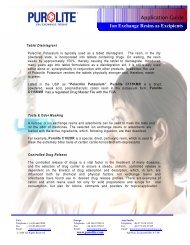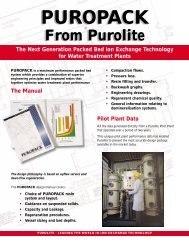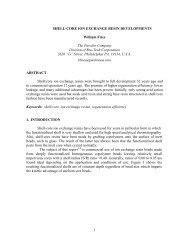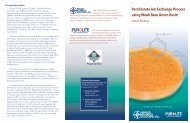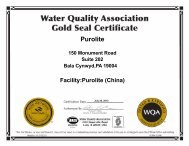Cane Sugar Refining - Purolite
Cane Sugar Refining - Purolite
Cane Sugar Refining - Purolite
You also want an ePaper? Increase the reach of your titles
YUMPU automatically turns print PDFs into web optimized ePapers that Google loves.
Glossary (continued)<br />
<strong>Cane</strong> <strong>Sugar</strong> <strong>Refining</strong> with Ion Exchange Resins<br />
44<br />
DISSOCIATE: The process of ionization of an<br />
electrolyte or a salt upon being dissolved<br />
in water, forming ions of cation and anion.<br />
DOWNFLOW: Conventional direction of<br />
solutions to be processed in ion exchange<br />
column operation, i.e., in at the top,<br />
out at the bottom of the column.<br />
DRY SOLIDS: The matter, usually expressed<br />
in weight percent, remaining after liquid<br />
removal.<br />
EFFICIENCY: The effectiveness of the<br />
operational performance of an ion<br />
exchanger. Efficiency in the adsorption<br />
of ions is expressed as the quantity of<br />
regenerant required to effect the removal<br />
of a specified unit weight of adsorbed<br />
material, e.g., pounds of acid per kilograin<br />
of salt removed.<br />
EFFLUENT: The solution which emerges from<br />
an ion exchange column.<br />
ELECTROLYTE: A chemical compound which<br />
dissociates or ionizes in water to produce<br />
a solution which will conduct an electric<br />
current; an acid, base or salt.<br />
ELUTION: The stripping of adsorbed ions<br />
from an ion exchange material by the<br />
use of solutions containing other ions in<br />
relatively high concentrations.<br />
EQUILIBRIUM REACTIONS: The interaction<br />
of ionizable compounds in which the<br />
products obtained tend to revert to<br />
the substances from which they were<br />
formed until a balance is reached in<br />
which both reactants and products are<br />
present in definite ratios.<br />
EQUIVALENT WEIGHT: The molecular weight of<br />
any element or radical expressed as grams,<br />
pounds, etc., divided by the valence.<br />
EXCHANGE SITES: The reactive groups on an<br />
ion exchange resin.<br />
EXCHANGE VELOCITY: The rate with which one<br />
ion is displaced from an exchanger in favor<br />
of another.<br />
EXHAUSTION: The state in which the resin is<br />
no longer capable of useful ion exchange;<br />
the depletion of the exchanger’s supply of<br />
available ions. The exhaustion point is<br />
determined arbitrarily in terms of: (a)<br />
a value in parts per million of ions in<br />
the effluent solution; (b) the reduction in<br />
quality of the effluent water determined<br />
by a conductivity bridge which measures<br />
the electrical resistance of the water.<br />
FMA: The free mineral acidity, or sum of<br />
the mineral acids.<br />
FINES: Extremely small particles of ion<br />
exchange materials.<br />
FLOW RATE: The volume of solution passing<br />
through a given quantity of resin within a<br />
given time. Usually expressed in terms of<br />
gallons per minute per cubic foot of resin,<br />
as milliliters per minute per milliliter of<br />
resin, or as gallons per square foot of resin<br />
per minute.<br />
FREEBOARD: The space provided above<br />
the resin bed in an ion exchange column<br />
to allow for expansion of the bed during<br />
backwashing.<br />
GRAIN: A unit of weight; 0.0648 grams.<br />
GRAINS PER GALLON: An expression of<br />
concentration of material in solution,<br />
generally in terms of calcium carbonate.<br />
One grain (as calcium carbonate) per gallon<br />
is equivalent to 17.1 parts per million.



